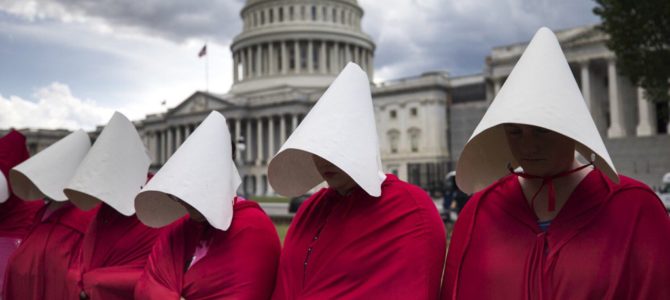
I keep feeling like I’m in an episode of “That 70s Show.” Not only are bell-bottoms back in style, but, like the 1970s, women’s issues are front and center in the political conversation.
Another striking similarity between the 1970s and now is the national birth rate. In 1975, Time magazine awarded their Man of the Year award to The Women. The birth rate that year dropped to 1.77 births per woman. In 1976, an all-time low was hit of 1.74 births per woman, even lower than during the Great Depression.
In 2017, Time Magazine gave its Person of the Year award to The Me Too Silence Breakers, and the country’s fertility rate fell to 1.76. This year the record low birth rate continues.
Low fertility rates, like those of the 1970s, are generally considered the manifestation of a poor economy, but there is evidence that this is not always the case. Martha J. Baily and Brad J. Hershbein write in U.S. Fertility Rates and Childbearing, 1800 to 2010:
The Great Depression and the baby boom pose challenges to the simple demand-side narrative. As the economy entered the Depression, the downward trend in fertility rates changed little in pace. Even as per-capita disposable income plummeted by 23 percent between 1929 and 1932 (Bureau of Economic Analysis 2015: Table 7.1), the general fertility rate fell by a mere seven births per 1,000 women (55.9 to 48.6) between 1930 and 1933 (lagged one year because births occur nine months after pregnancies). But the fertility rate had declined by about 6 births per 1,000 women between 1927 and 1930 (61.4 to 55.9) (Linder and Grove 1947). Thus, the speed of fertility decline barely budged from its earlier trend.
The current birth rate is at an historic low this year, while concerns about the economy are also at a record low. What does seem to correspond with plunging birth rates is not just the economy, but also the cresting of a feminist wave.
First Wave Feminism culminated in the 1920s. There was the ratification of the 19th Amendment in 1920, the first woman was elected to the U.S. Senate in 1922, and the liberated flapper became the emblem of the era. The 1920s also saw rapidly declining fertility rates, despite rising economic prosperity. As Baily and Hershbein’s article points out, the advent of the Great Depression did keep birth rates low, but actually appears to have slowed the rate at which fertility had been plummeting during the prosperous Roaring Twenties.
The 20-year Baby Boom that followed the Great Depression ended in the early 1970s, the high-water mark of Second Wave Feminism. The 1970s Supreme Court declared sex discrimination a violation of the 14th Amendment and legalized abortion in 1973. The International Conference of Women was in 1975, and in 1976, national birth rates were the lowest in American history.
In the midst of feminism’s Third Wave, the current cultural landscape looks eerily similar to that of the mid 1970s. The Me Too movement has shown its power from Hollywood to the Supreme Court. The state of California has passed a law that requires publicly traded companies to hire at least one woman on their boards. There is an unprecedented level of women running for political office this year, and birth rates hover at almost exactly the same low as in 1976.
Another trend that occurs at the height of each wave of feminism is a kind of crisis of female body image. In the 1920s, styles shifted from the curvy Gibson girl of the early 1900s to the slim, straight-hipped flapper who taped down her breasts to make herself look more boyish. It was in the 1970s that anorexia first became a widespread problem. Hilde Bruch’s book, “Eating Disorders: Anorexia, Bulimia and the Person Within,” was published in 1973 and, according to Psychology Today, “As the disorder reached public awareness in the 1970s, cases increased.”
Women’s clothing styles in the ’70s shifted away from the overt femininity of the ’40s, ’50s, and even the mod ’60s, and became more sex-neutral. The body image crisis of Third Wave Feminism is described by Robert Tracinski in a recent article. Recently, the clothing company Acne Studios has received a lot of publicity for its androgynous line of teen fashion.
Each wave of feminism seems to end, ironically, by turning on femininity itself. It is as if feminists are trying to stop victimization by eliminating the victims. Women should not all have to look like a 1950s housewife, of course, but it is no surprise that a glamorization of masculinity would correspond with women shunning the very female act of having children.
A comparison of the three most significant decades of feminism leads to the seemingly obvious, but often unrecognized, conclusion that birth rates depend on women’s attitudes. Macro events, such as the economy, may actually have a less significant impact on fertility than micro influences like peer pressure or what kind of lifestyle is culturally encouraged and respected.
The good news is that with 2018 looking so much like 1976, we may be at the peak of Third Wave Feminism and about to see a rebound in birth rates. There would certainly be some interesting synchronicity if, having begun with Anita’s Hill’s testimony against Justice Thomas, and the subsequent Ms. Magazine article, “Becoming the Third Wave,” this era of feminism ended around the time of Christine Blasey Ford’s high-profile accusation against Brett Kavanaugh.
Indeed, a recent Gallup poll indicates that attitudes have already begun to change. According to Gallup, “The current share of adults who see three or more children as the ideal family size is the highest since 1997.”
Third Wave Feminists are onto something when they say the future is female. Anyone who values a stable national population should begin to think as seriously about the cultural attitudes of young women as they do about tax cuts and de-regulations. Listening to the opinions and feelings of young women — respecting their freedom and their femininity, and the incomparable contribution they make as mothers of the future — might just be the next generation of feminism.









